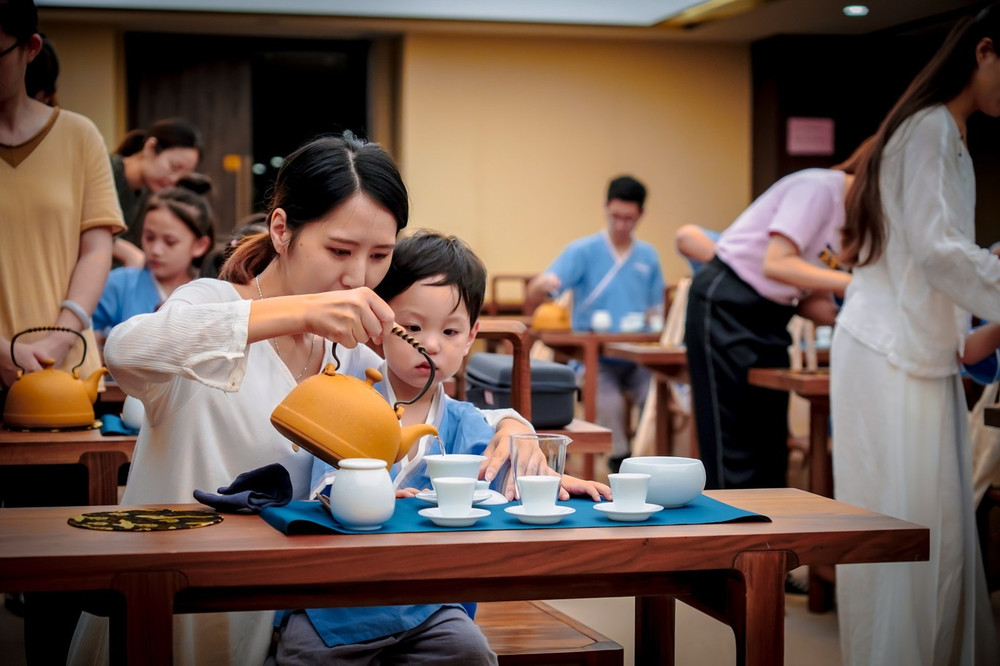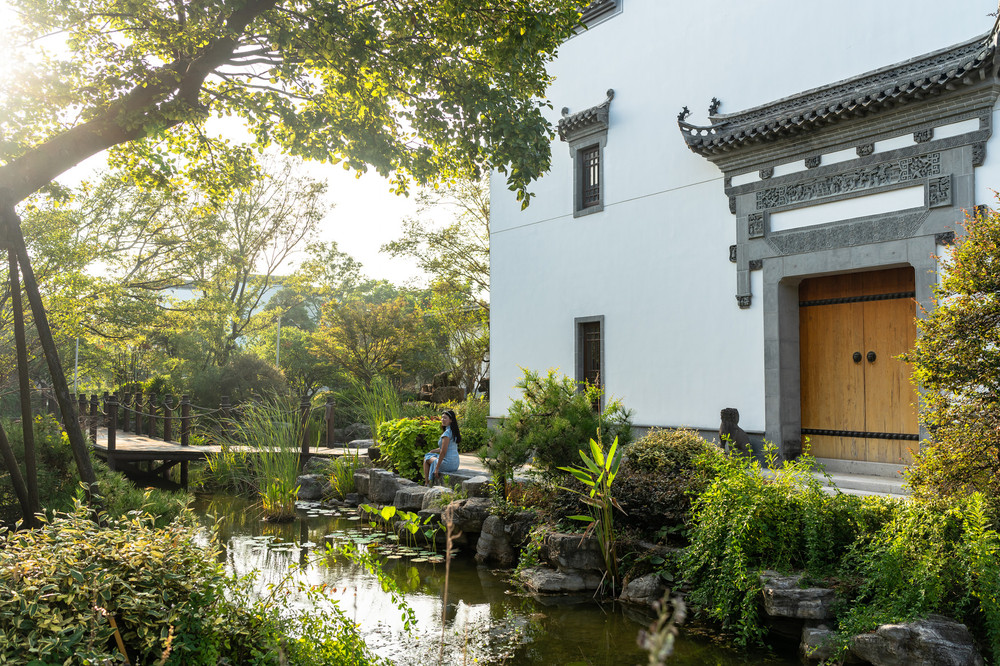Gameplay: Gourmet

Published on April 20, 2024
“Four-Hands Dinner”
The term “Four-Hands Dinner” originates from the world of piano performance, where it describes a collaborative effort between two musicians. In the realm of high-end cuisine, it has taken on a new meaning, referring to a dinner prepared collaboratively by two renowned chefs. This concept, often simply referred to as “Four-hands,” implies a close partnership between the two chefs as they work together to create a harmonious dining experience.
When it comes to a “Four-Hands Dinner” that’s worth the price, both chefs are typically well-established and influential in their industry. My initial reaction to the concept was one of excitement, as if my teeth and tongue were dancing in anticipation. However, my enthusiasm has since waned. The market is now saturated with such collaborations, leading to a sense of chaos and a dilution of the original concept. While the idea of collaboration sounds straightforward, it is, in fact, challenging to execute well. Sometimes, the chefs work separately, which can detract from the intended synergy.
In my opinion, the most exciting collaborations occur when two chefs with distinct styles come together to create a unique culinary experience, akin to a national symphony or a rural heavy metal band. This eclectic blend is what diners look forward to the most.
However, the reality is that chefs in high-end restaurants are often as busy as warriors on a battlefield, leaving little time for the meticulous planning and creation required for a successful “Four-hands” collaboration. Achieving a seamless and highly integrated dining experience is no easy feat.
While there are instances of chefs finding a kindred spirit in their collaboration, akin to the legendary friendship between Boya and Ziqi, such private improvisations are acceptable. However, in a formal setting, it can be seen as irresponsible. Stability is key for a grand banquet, and the last thing one wants is to create “surprises.”
A recent example of a “Four-Hands Dinner” that captured the essence of the concept was “Tasting Suzhou City,” presented by Zhang Li from Suzhou W and Xu Jie from Xingguo Hotel. Gourmet teacher Shen Jialu aptly noted that “Suzhou people are the taste mentors of Shanghai people,” reflecting the culinary history of the region.
For a successful collaboration, I believe the following points are crucial:
1. The chefs’ previous creations should all relate to a certain major theme of the collaboration.
2. The chefs’ cuisine or expression style should be similar.
3. The chefs should admire each other, and the teams should have a foundation for tacit cooperation.
Master Zhang Li, based in Suzhou, and Master Xu Jie, based in Shanghai, both have backgrounds as masters of Suzhou cuisine. Zhang Li innovates Suzhou cuisine from a global perspective, while Xu Jie inherits it from the rules of state banquets. Their intersection of innovation and inheritance has merged into a unique flavor of Suzhou and Shanghai.
Before any collaboration begins, it is best for the orchestra conductor, composer, and music critic to have a meeting. In the context of our Suzhou cuisine catering circle, the organizing committee, consisting of Director Huang Xin, Xu Hefeng, Hua Yonggen, and teacher Shen Jialu, forms a high-level forum of uncles from Shanghai and Jiangsu. They discuss dishes with great interest, offering insights into the essence of Shanghai cuisine, which is a great fusion of Anhui cuisine, the “spade gang,” and Suzhou cuisine, with Suzhou cuisine at the top of the pyramid.
Teacher Shen Jialu described the lunch as a blooming of flavors on the tip of the tongue. While the experts share their feelings, the diners on the other side have already started to savor the experience. I, along with colleagues from various fields, envy the “young woman” wearing a pearl necklace at Fengmen vegetable market. She strolls leisurely and ostentatiously, but she deserves her confidence. I’m not envious of her mink coat wrapping her divine body like in Rubens’ paintings; I’m just curious about her meals. Her mouth is like a vegetable basket that doesn’t leak deliciousness but only drools. No matter how picky her taste is, she doesn’t have to worry, as Suzhou cuisine offers all good things.However, chefs in high-end dining establishments are usually as busy as soldiers in their daily lives, and it’s challenging for them to find time to rearrange the music (create dishes), to perform a highly integrated piece (meal) that presents a solid ‘Guangling Melody’ four-hands collaboration. It’s not that there aren’t situations where one can always accompany the pine waves and chant elegant rhymes, or where one can encounter a confidant in the mountains and flowing waters, but it’s irresponsible to improvise on stage. I believe that large banquets require stability and the last thing they need is to create ‘surprises’.
Recently, I attended a ‘Taste of Suzhou’ four-hands dinner presented by Zhang Li from Suzhou W and Xu Jie from Xingguo Hotel, which somewhat resembled the original idea of a four-hands collaboration. Gourmet Shen Jialu said well, ‘The people of Suzhou are the taste teachers of the people of Shanghai’, which actually refers to the history of the cuisine. I believe that a successful collaboration depends on the following points: 1. The chef’s previous creations are related to a certain collaborative theme. 2. The chefs’ cuisines or expressive styles are similar. 3. The chefs appreciate each other and have a basis for teamwork and cooperation.
Coincidentally, Master Zhang Li is in Suzhou, and Master Xu Jie is in Shanghai; both have backgrounds as masters of Suzhou cuisine, with the former innovating Suzhou from a global perspective and the latter inheriting Suzhou from the rules of state banquets. Of course, the intersection of innovation and inheritance between the two has just merged into a unique flavor of Shanghai and Jiangsu.
Before any serious collaboration begins, it is best for the conductor, composer, and music critic to hold a meeting. In the context of our Suzhou cuisine dining circle, the organizers are the true masters of Suzhou cuisine. General Manager Huang Xin, Xu Hefeng, Hua Yonggen, and Teacher Shen Jialu, with great interest, chatted about the dishes and temporarily formed a high-level forum of uncles from Shanghai and Jiangsu. The essence of Shanghai cuisine is a great fusion of Hui cuisine, the ‘spatula gang’, and Suzhou cuisine, with the pinnacle being the modest, unassuming, and gentle Suzhou cuisine.
The experienced gentlemen speak with substance, revealing the truth in a single stroke. Mr. Shen Jialu says that this lunch is a blooming feast on the tip of the tongue. While experts are discussing emotions, diners have already begun to sharpen their teeth. I speak for myself and my peers with distinguished faces. I envy the ‘young married woman’ at Fengmen Market wearing a pearl necklace, strolling leisurely under the eaves, flaunting herself, yet rightfully confident. I am not coveting the fur-wrapped divine body under the brush of Rubens. I am merely curious about her meals; her mouth is a basket that only retains delicious food and secretes saliva, no matter how picky one is, for Suzhou cuisine is filled with delicacies. The fresh produce in the market looks tender and dripping, grown naturally, and possesses the power to transcend time. Now, with an invitation letter in my pocket, I see the distant smoke from cooking, eating slices of Suzhou water chestnuts, waiting for the soul’s fragrance. This is the procurement conference of a duet, I am carrying a pastry in my right hand and another in my left, following two seasoned ‘fresh meats’ to explore the first place to find ingredients in Suzhou: Fengmen Market. Zhang Li and Xu Jie, who can discuss various Suzhou ingredients at length, are the right people to follow.
Two years ago, after writing a long article about my childhood love for Suzhou pastries, I decided to cut out carbohydrates after eating pastries for two weeks. But the taste of pork fat seeping into glutinous rice is truly captivating! Li Bai always thought about a thousand gold, but my mind keeps echoing ‘a thousand catties spent and yet they return’. Ah, eat.
Suzhou cuisine has always carried a scholarly air, developed by the kitchens of the gentry, and spread far and wide due to the fame of literati. I have just written about Yunlin goose and Ni Yunlin, and now, at a glance, ‘Luzhi’ makes me think of Lu Gui Meng’s Fuli duck soup. The deep friendship between gourmet and literary giant Lu Wenfu and Zhou Shoujuan began over shared meals. There is a secret to eating well, in Lu Wenfu’s words, it is to ‘eat the chef’, not the restaurant. Those who do not know how to eat only ‘eat at the restaurant’. Zhou Shoujuan, after ordering a chef, would no longer order dishes, ‘ordering more dishes would be a bit petty, and it could easily disrupt the chef’s overall design.’And the unique character ‘ao’ in Suzhou cuisine, Zhang Li educated me, means to bury food in the embers and cook it slowly. It is not because it is special, but because the stove fire used to be limited by wood, and could not be extinguished immediately, so cooking with the residual heat of the burnt wood became a unique method. Isn’t this low-temperature slow cooking?! I still have countless reveries for the revival of ancient dishes, where tradition and modernity may collide to create new miracles.
In ancient times, Luzhi was also called Fuli. The Tang Dynasty poet Lu Gui Meng once resided here, calling himself ‘Mr. Fu Li’. The Fu Li duck soup, also known as Dao Geng Tang, was originally prepared by Lu Gui Meng himself to entertain his friend Pi Ri Xiu. Regardless of the technicalities of the soup made by the great poet, the sentiment and sincerity must be present. Recently, I had the fish lip duck silk soup at Lu Yu in Hong Kong, which seems to be connected to this ancient dish. There are countless stories in the bustling market, and the specific lineage of inheritance is unknown. However, Fu Li duck soup is much more delicate and complex, with tender duck, ham, tendons, scallops, river shrimp, magnolia slices, mushrooms, shepherd’s purse… Just looking at the ingredients, one can already feel the freshness! There is a saying in Luzhi: ‘Eating Fu Li duck soup, even a slap won’t let go.’ It seems that after strolling in the hot market, I ate at various stalls and had a dreamy illusion of a burning sensation on my face.
I will always remember the moment when the uncles suddenly decided to visit the W kitchen in Suzhou, the confidence and long-standing composure on the faces of chefs Zhang Li and Xu Jie. After buying the ingredients, a good meal is about to begin!
The meticulously crafted AB menu of Suzhou W. I asked Zhang Li: ‘A single performance of two new dishes?’ Zhang Li chuckled: ‘Doing a banquet is like recording a variety show for me, if there’s an emergency, there must be a backup plan.’
Menu A: The Easy Version – Zhang Li independently developed a ‘Blooming Prosperity’ dish, with squid petals, cilantro flower as the stamen, and caviar as the core, elegant and graceful. With a cry of ‘Winds Rise and Water Stirs’, the splendid fisherman’s catch is full of good fortune. Sixteen flavors of abalone bloom on the plate. The newly listed shepherd’s purse lays the runway for the ‘Dragon Flight’ (lobster), and I have the courage to not exceed weight after eating Qianlong sauce meat (Suzhou’s sauced meat sandwich). People on the road in rainy and snowy weather will surely envy Zhang Li’s bowl of ‘Borscht Noodles’, which really contains Russian red sausage, and the instant noodles also have the face of a northerner. I added some ‘Seedling Vegetables’ from the table, the crunch of the soaked cabbage, the glutinous edge of the turtle, and the freshness of the grass head, which will make any smart southerner instantly forget the anxiety of driving an electric car stuck in traffic watching the A-share market. Finally, a bowl of red osmanthus chicken head rice syrup, the New Year is sweet and full of variety, red!
Menu B: The Zhou Edition – Zhang Li + Xu Jie co-developed ‘Blooming Prosperity’ by Zhang Li – The first cold dish ‘Blooming Prosperity’, Master Zhang Li chose cherry radishes soaked in red beet juice, paired with sweet and sour spicy scallops, the same shape and color, but different flavors. Cherry radishes and scallops are arranged on the plate in the shape of peonies, decorated with Thousand Island Lake caviar and cilantro flowers, symbolizing prosperity and blooming fortune. ‘Dragon Flight’ by Zhang Li – The second cold dish ‘Dragon Flight’, Master Zhang Li uses low-temperature slow-cooked small blue lobsters, paired with fresh sea urchin, and topped with transparent yellow wine jelly, arranged with spicy lobster legs, rich and fragrant taste, opening the taste buds, symbolizing the dragon’s good fortune and rising to prominence. Spring Reflection Abalone by Chef Zhang Li – The third cold dish, ‘Spring Reflection Abalone’, features Chef Zhang Li’s selection of fresh six-head abalones from Dalian. Inspired by the transition from winter to spring, the dish presents abalone in two flavors: one with the winter-stored preserved plum vegetable, and the other with the spring symbolizing fern sauce. Swallow’s Nest Fresh Soup by Chef Zhang Li – The soup dish ‘Swallow’s Nest Fresh Soup’ sees Chef Zhang Li using an entire pig’s trotter and a whole duck, complemented by salted meat, spring bamboo shoots, and yuba knots, simmered slowlyThe arrival of spring is celebrated with a dish filled with dried golden vegetable stuffing, accompanied by fresh golden vegetables, offering a soft, fragrant taste. Pan-fried Fish Dumplings by Chef Xu Jie is the second hot dish, featuring the rare and seasonal pond fish, now a delicacy. Chef Xu Jie minces the skinless fish meat, preserving the fibers, and wraps it with net oil, pan-frying it slowly until golden brown, then embellished with glistening fruit vinegar. The large dumpling, with a skin as thin as cicada wings yet smooth and tender, melts in the mouth with a rich, oily sheen and a harmonious blend of flavors.
The third hot dish, ‘Universe Fermented Square’ by Chef Xu Jie, lives up to its name, containing a ‘universe’ within. A simple piece of fermented square meat reveals a filling of sea cucumber, abalone, scallops, conch meat, ham, chicken gizzard, diced meat, and chicken head rice between the layers of fat and lean meat, releasing a rich sauce as it is cut open. This square of meat, with its grand flavors, offers a luxurious taste experience, combining the aroma of fermented meat with the freshness of seafood.
Inspired by a Suzhou saying, ‘Snails before the bright moon are as rich as geese,’ Chef Zhang Li presents the staple dish ‘Green Snail Rice.’ Before the Qingming Festival, as the grass grows and the orioles fly, there are many seasonal spring delicacies to admire. Chef Zhang Li selects the fresh and tasty snail meat, stir-frying it with silver fish sauce in a clay pot, accompanied by shrimp, scallop threads, and green chili peppers, leaving a lasting freshness on the lips.
This Suzhou-flavored dessert ‘Water Green Spiral’ by Chef Zhang Li is an innovative creation. It uses the water caltrop, which resembles tea leaves, to make a jelly, shaped into a spiral with matcha ice cream and chocolate, paired with spinach juice. The taste is refreshingly sweet, and the touch of green evokes thoughts of the layered green spiral spring tea mountains of Taihu Dongshan.
From seeing the mountain as a mountain, to not seeing the mountain as a mountain, and finally returning to seeing the mountain as a mountain, this is the most memorable meal of the year. After much consideration, when Chef Zhang Li presented the main course at the W Hotel in Suzhou and the Xingguo Hotel in Shanghai, it was still Menu B that was showcased.
Huang Xin is always in charge. Together with Master Hua Yonggen, Master Xu Hefeng, and Teacher Shen Jialu, they have provided ‘even better’ blessings in terms of materials, flavors, shapes, utensils, and culture. This makes me extremely look forward to the next banquet. For people in Jiangnan, elegance in dining is from the inside out. Teacher Barbie wrote about the highest realm of a good meal: ‘Not piled up with too many high-end ingredients. From shape to flavor, it is comfortable.’ This is equivalent to the splendid lining of a dining table.
Now we come to Xingguo Hotel. In the spring of ‘flowers in full bloom’ with new green everywhere at Xingguo Hotel, Shanghai truly welcomes ‘flowers in full bloom.’有幸到兴国宾馆一号楼赴一场春宴,This copper-roofed ‘copper house’ that has been in use since 1934 has entertained countless political dignitaries and recorded the infinite glory of celebrities. At the beginning of the banquet, I asked Teacher Li Shu and Teacher Shen Jialu online about the origin of ‘bald lung’ and ‘Farewell My Concubine.’ Interestingly, Master Xu Jie’s skills are all in the style of state banquets. These days, he is cooking ‘Farewell My Concubine’ every day. A bowl of rich chicken soup is full of ‘treasures.’ In the photos he casually took, there are boneless tiger palms (turtle legs) and pieces of native chicken, as well as two essences: turtle skirt and ham hock. I can’t help salivating. A few days ago, there was an astonishing dish of crab roe and globefish ‘bald lung’ in Zhang Li’s boat banquet. In fact, it is a perfect upgrade of black carp ‘bald lung,’ inspired by the famous Suzhou dish ‘crucian carp lung soup.’
I thought that in this Shanghai duet of Xingguo Hotel and Su Yan of W Suzhou Hotel, Chefs Xu Jie and Zhang Li, dressed like black and white piano keys, are more than capable of playing a splendid banquet of Suzhou cuisine version! Rose-Marinated White Shrimp, Spring Leek and Snail Meat, Smoked Conger Pike by Xu Jie. Rose-Marinated White Shrimp – Spring Leek and Snail Meat – Smoked Conger Pike. The delicate cold dishes in the ivory white treasure box start fresh. A Sip of Spring Soup by Xu Jie. Chef Xu Jie picked bamboo shoot tips, cabbage heads, broad bean seeds, and pea pods, and decorated them with the buds and leaves of this year’s Biluochun new tea, forming this ‘a sip of spring soup’ that is the most precious. The hours-long carefully stewed Jiuhua Mountain native chicken and ham have created a high-grade clear soup with the color of tea.The First Sip of Spring Soup
This delectable soup is crafted from a high-grade meat broth, tinged with the color of tea. It is complemented by seasonal mountain bamboo shoot tips, spring broad beans, honey peas, fresh abalone slices, and fresh Biluochun leaves. The resulting soup is clear, fragrant, and fresh, offering a taste of the seasonal vegetarian freshness that is both sweet and refreshing, with rich layers of flavor, evoking the essence of spring in the mountains and fields.
Fish Maw with Pig’s Knee Bone
Next, we have a dish called ‘fish maw with pig’s knee bone’, which is smothered in a thick sauce. The ‘butterfly bone’, as it’s known, is the knee bone of a pig, a unique piece that combines fat, lean meat, and cartilage. Though the bone itself may not be visible, its presence is felt as it delights the palate with a dance of flavors reminiscent of butterflies.
A Culinary Revival
National-level culinary master and Suzhou cuisine expert, Mr. Xu Hefeng, remarks that this old dish is rarely made today, making it a rare treat to enjoy. Once a dish on the brink of being lost to history, it has been brought back to life through in-depth research, understanding, and innovative improvements. This Suzhou-flavored dish, rich in ‘strengthening body and bones’, has been reintroduced for the spring season. The ingredients are carefully selected, using only two knee bones from black-haired pigs, which are paired with fish maw to create a dish with a unique fusion of gelatin and a distinctive flavor.
Pond Slice Small Green Dragon
Chef Zhang Li presents ‘Pond Slice Small Green Dragon’, a dish that employs the Suzhou pickled cooking method. The ‘pond slice’ fish, taken from the body meat, is combined with small green lobster balls and steamed with an egg white base to enhance the sweet taste within the pickled fragrance. Pond fish, a favorite among Suzhou locals in spring, typically weigh around 100 grams each. Two slices of its meat are paired with lobster meat, blending seafood and river delicacies with the renowned Suzhou pickled flavor, adding more artistic flair and deliciousness to the vibrant spring season.
Apron Lotus Root Stomach
Another rich-flavored dish by Chef Zhang Li is ‘Apron Lotus Root Stomach’. The seasonal belly of the sturgeon fish in spring is stuffed with water chestnut shoots and turtle apron, complemented by the smooth apron of the vegetable flower turtle ‘tempura’ and millet grass. Zhang Li notes that the vegetable flower turtle in spring is the season’s best ingredient, and the turtle’s apron, when fried using the tempura method, pairs perfectly with the rich and delicious sturgeon fish of spring. The belly of the sturgeon fish is then added to the mix, with rich oil and sauce, making the apron crispy yet glutinous. This dish is jokingly referred to as the ‘spring longing’ fish, a topic that is also full of spring.
Morel Asparagus
Xu Jie’s ‘Morel Asparagus’ features morels stuffed with knife fish filling and a thick soup with white asparagus slices that are crisp. The dish uses selected rapeseed tips, with the first batch of morels filled with seasonal fish meat, paired with white asparagus. The fresh and fragrant fish soup soaks the ingredients, sublimating their freshness.
5J Chinese Toon Noodle
Xu Jie’s ‘5J Chinese Toon Noodle’ is a dish of handmade duck egg noodles mixed with 5J ham cubes and Chinese toon, with ham oil adding a fragrant touch.
Mallow Ice Cream and Cinnamon Apple Powder Balls
Xu Jie also presents ‘Mallow Ice Cream’ and ‘Cinnamon Apple Powder Balls’. The mallow ice cream is tempting, and the cinnamon apple powder balls are a delightful challenge to the green rice balls, reminding us that spring is not only about greenery but also about the tender pink of cherry blossoms. A good duet is a seamless whole, with musical richness filling from inside to outside. Two people can also play a symphony. This time, the moment they decided to play a duet, the performance had already begun…
Food Bless You!
A symphony is like a world. —— Mahler
Consultant of ‘Taste of the World’, host of ‘The Divine Table’, producer of ‘Eating Wild in China’ and ‘Worthwhile Life 369’.









